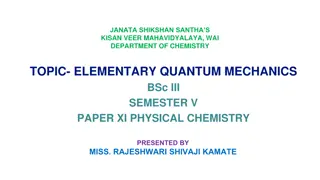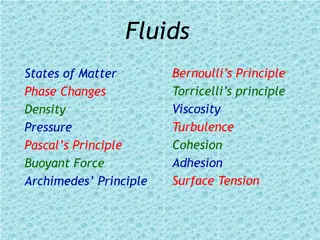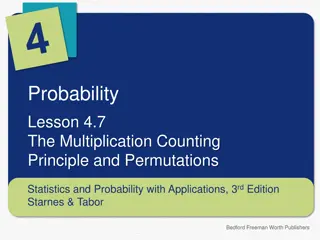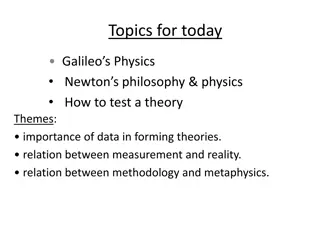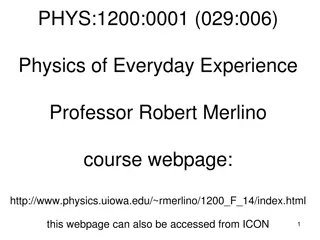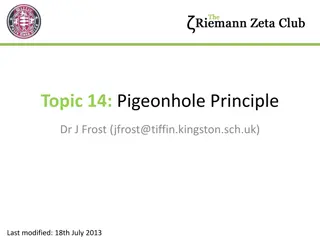Understanding the Anthropic Principle and the New Paradigm in Physics
Exploring the Anthropic Principle and the New Paradigm in physics, this content delves into the concept that our existence is inevitably privileged, as well as the potential unification of Quantum Mechanics and General Relativity. It reflects on the conditions necessary for life, the role of physical constants, and the uniqueness of our universe's properties.
Download Presentation

Please find below an Image/Link to download the presentation.
The content on the website is provided AS IS for your information and personal use only. It may not be sold, licensed, or shared on other websites without obtaining consent from the author. Download presentation by click this link. If you encounter any issues during the download, it is possible that the publisher has removed the file from their server.
E N D
Presentation Transcript
Anthropic Principle Although our situation is not necessarily central, it is inevitably privileged to some extent. Brandon Carter in a symposium honoring Copernicus 500 birthday, 1973 Is there an excessive reliance on the Copernican principle" that the situation of man in the Universe is in no way special? Term paper rough draft due in Compass today (April 17) Final version due on May 3. No late papers accepted. Final exam on May 8, 1:30 4:30pm
The new paradigm If the effort to unify Quantum Mechanics and General Relativity is successful, all forces (fields) and particles will be seen as the same kind of entity. This includes the geometry of the universe, which GR has made into a dynamical entity. The structure of the universe, and of space-time itself, is determined by the interactions between the various particles. This may lead to an issue of uniqueness and self-consistency: For a given general form of theory, is there only one set of dimensions, particles and interactions that might be found, or are there possible ranges of allowable coupling constants? If the form of the theory doesn't specify all those numbers, what does?
A background story Suppose we measure the chemical composition of the Earth s atmosphere. We will find it to be 21% oxygen. There is no significant ammonia. This isn t the state of affairs on other planets and moons. Is it surprising that this is just right for us? No: We evolved to fit this environment. Our ancestors would have been killed by oxygen. They gradually evolved to use it as photosynthesis dumped more into the atmosphere. Is it surprising that the environment is even in the right general range for life? E.g. not like the surface of the sun, or a neutron star, etc.? No. There are all sorts of different environments. (>100,000,000,000 galaxies, about 100,000,000,000 stars per galaxy, many with planets ) On the ones that can t support life, nobody is asking why. Is it surprising that the physical laws themselves and the basic physical properties of the universe as a whole allow that range of environments?
Some Facts to Explain All the physical constants have to have precisely the values we observe in order for humans to evolve, since biology is very sensitive to chemistry, and chemistry is very sensitive to those constants. However, we can imagine slightly different values, giving rise to different chemistry and hence different creatures, who might then wonder how it was that the universe was set up so carefully for themselves. What we are really interested in is what general conditions are necessary for the evolution of any creature capable of asking this question. Many physical constants, not currently constrained by any established theory, probably have to have values very close to those that we observe in order for any life to evolve. Is this speculation or fact?
Conditions for life We re ignoring anything required for our particular complex chemistry, just looking for preconditions for some sort of long-term complex chemistry. 1. Shape of the universe ( 0) a dense universe would collapse before anything could evolve. A sparse universe wouldn't form galaxies, second generation stars, elements with interesting chemistry 2. The strength of the attractive nuclear force has to fall within a fairly narrow range (a factor of about 1.5) to make deuterium stable, but not diprotons. Outside that range, there's no apparent way to form heavy elements. 3. There's a particular excited state of the carbon nucleus whose energy just matches up with the rest mass of three helium nuclei. This allows carbon to form, and hence the heavier elements. These energy levels have to be very fine-tuned. Maybe there are other possible tunings that would work, but it seems that in a random draw of the strengths of these interactions (near the current values) most results wouldn't allow heavy elements to form.
Anthropic Principles Attempts to explain these interesting facts are called Anthropic Principles (see Hawking) Strong Anthropic Principles Typically restatements of purpose-based religious explanations Weak Anthropic Principles explanations based on self-selection from a huge, mostly dead, ensemble. Why did the big bang occur 14 billion years ago? Why is the earth 93 million miles from the sun?
Weak Anthropic Principles 1. Since our existence is a precondition for observations, and various physical facts are preconditions for our existence, there is no point in trying to explain those physical facts. They just have to be true. It leads to dropping research topics. In its extreme form, it means dropping questions about the origin of any physical properties, since if you change any, we wouldn't be here. It means dropping any questions about the fundamental physical constants, since if they were much different, nobody would be anywhere. There has already been a good deal of progress in reducing the number of separate parameters needed to describe the world (e.g. in the unifications of forces), so it doesn't make sense to drop that endeavor mid-stream. It now seems that =1 may result from inflation- it would have been a shame not to have investigated just because life needs to have ~1. Many Tries (sometimes considered a form of the Strong Anthropic Principle) If the universe has some of the properties it has (e.g. strength of nuclear force) because it is self-selected, so there must have been some larger ensemble from which it was selected 2.
What Larger Ensembles? 1. Space-time Domains There are a variety of pictures of space-time which include distinct regions on which it is conceivable that the fundamental constants take on different values. (We don't know yet which parameters come from a deeper theory and which will still be able to take on any of some range of values.) E.g. In one inflationary picture, islands of non-inflating space nucleate randomly in an ever-inflating background. An infinite number of such islands will be created, making it inevitable that all the parameters which can take on a variety of values can be found somewhere with just the needed values for life. Many-worlds Quantum Mechanics: any parameters which were set by a quantum-mechanical process take on each possible value in some "world" residing in the overall phase-space. As wacky as these ideas (esp. the 2nd) may sound, they both arise from an attempt to understand otherphysical problems, not as an attempt to solve the anthropic question. So their solution of the anthropic question would be an added confirmation of their validity. 2.
What Can Be Selected? The key question is which parameters are set by more fundamental theories, and which are free to fluctuate among domains. That depends on the (not yet established) underlying Theory of Everything, including quantum gravity. String theories are estimated to have about 10500 different more-or-less stable solutions. They have a range of dark energy densities, probably a range of different numbers of extended dimensions, etc. Let s just look at the dark energy cosmological constant, . Something (inflation??) makes the total energy density =1.00. That seems to go way beyond anthropic requirements, so let s assume it has another explanation. = M+ Na ve pictures of the vacuum (just zero-point EM radiation up to the Planck frequency) give: ~ 10125, a significant discrepancy. Anthropic constraint requires M ~1, so | | < 1. If that s the only constraint on , you expect a value not much less than 1. E.g. 0.7! (out of a range of maybe +/- 10125) Weinberg made this ~predictive argument in 1987!
Note- were ignoring anything required for our particular complex chemistry, juts looking for preconditions for some sort of long-term complex chemistry. 4. Fine-tuning of inflation potential? Special shape is needed to give soft-landing after inflation. Alternate: fine-tune early density, temperature, over huge space 5. Early low-entropy state of spacetime?
A New Paradigm? So one possible new method in the search for understanding , e2/hc, and the other 20+ some unexplained basic numbers is: Figure out what the possible values are allowed by a TOE. Assign prior probability values to each little parameter range, based on something like how many ways the TOE can give that range. Multiply the prior probabilities by some measure of how many minds are likely to arise to observe those parameters, if they occur. Problems: We don t yet have good candidates for a TOE. We don t really know how to assign prior probabilities to parameter values, even if Weinberg managed to successfully fudge some in 1987. We don t know how to calculate the number of minds, or even how to deal with the infinities in typical geometries.
Fine-Tuning Inflation We saw inflation correctly predict: 1. Flatness of universe 2. Homogeneity of universe 3. Absence of magnetic monopoles 4. Many details of the microwave background If you just granted it: 1. The right general sort of scalar potential 2. Fine-tuned so that the end of the rapid inflationary roll is gentle, not a huge energy dumping crash. ?
Inflationary Problems Why the fine tuning? Was the prediction theoretically correct? favoring inflation: the agreement between the predictions formulated in the early 1980s and the magnificent cosmological observations available today. Matching experiments trumps any theoretical argument. But the strange twist to this story is that the predictions of the early 1980s were based on a naive understanding of how inflation actually works a picture that has turned out to be dead wrong. The Inflation Debate Paul J. Steinhardt Scientific American 304, 36 - 43 (2011) (Steinhardt is one of the early proponents of inflation.)
Inflation Issues Zeroth issue (recognized early in the inflation discussion) Parameters have to be fine-tuned to get the sort of Goldilocks universe in which something could live. Can we use anthropic selection to account for that? Where do we get the ensemble to select from? Birth of new inflating bubbles from old cold flat empty universes? see Sean Carroll, From Eternity to Here: Revisiting Boltzmann s arguments. Assume that universes are mostly high-entropy. That turns out to be cold and flat, in the very long run, after black hole evaporation. Our universe started as low entropy because it was just a tiny quantum fluctuation out of that high-entropy situation. Then it grew by inflation. Eternal inflation?
Too Much of a Good Thing? A problem shared by all such anthropic pictures: Our universe is much larger and more homogeneous than needed (so far as we know) to form life. There should be much more net volume of livable space in smaller universes. Why aren t we there? Have we Missed something needed for anthropic selection? Missed something major in cosmology? This problem was already present for Boltzmann s anthropic ideas about the origin of the Second Law (initial low entropy). Why over such a big volume?
Paul Davies's book The Goldilocks Enigma (2006) enumerates choices: The absurd universe: Our universe just happens to be the way it is. The unique universe: There is a deep underlying unity in physics which necessitates the Universe being the way it is. Some Theory of Everything will explain why the various features of the Universe must have exactly the values that we see. The multiverse: Multiple universes exist, having all possible combinations of characteristics, and we inevitably find ourselves within a universe that allows us to exist. Intelligent Design: A creator designed the Universe with the purpose of supporting complexity and the emergence of intelligence. The life principle: There is an underlying principle that constrains the Universe to evolve towards life and mind. The self-explaining universe: A closed explanatory or causal loop: "perhaps only universes with a capacity for consciousness can exist." This is Wheeler's Participatory Anthropic Principle (PAP). The fake universe: We live inside a virtual reality simulation. cosmological natural selection: universes have "offspring" which are more plentiful if they resemble our universe
Criticisms of the Anthropic Principle "it tends to be invoked by theorists whenever they do not have a good enough theory to explain the observed facts. Penrose Tautology, an elaborate way of saying "if things were different, they would be different . "in its weak version, the anthropic principle is a mere tautology, which does not allow us to explain anything or to predict anything that we did not already know. In its strong version, it is a gratuitous speculation Earman, McMullin, Mosterin "it is neither testable nor falsifiable, this is not a scientific statement but rather a philosophical one. The same criticism has been leveled against the hypothesis of a multiverse. The claim that the universe is fine-tuned for the benefit of our kind of life is equivalent to saying that sausages were made long and narrow so that they could fit into hotdog buns. Stephen Jay Gould


![[PDF⚡READ❤ONLINE] Black Hole Astrophysics: The Engine Paradigm (Springer Praxis](/thumb/21503/pdf-read-online-black-hole-astrophysics-the-engine-paradigm-springer-praxis.jpg)
